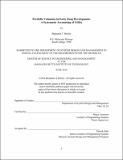Portfolio valuation in early drug development : a systematic accounting of utility
Author(s)
Burley, Benjamin T. (Benjamin Thomas)
DownloadFull printable version (2.243Mb)
Other Contributors
Massachusetts Institute of Technology. Engineering Systems Division.
Advisor
Bruce Cameron.
Terms of use
Metadata
Show full item recordAbstract
Pharmaceutical drug development is exhibiting a consistent trend of increased R&D investment required per successful therapy brought to market. Simultaneously, cultural and political sentiment is increasingly putting downward pricing pressure on new therapies. In this difficult environment it is clear increases in efficiency, as far upstream in this development process as possible, are critical. One aspect of efficiency in this industry is the accuracy with which drugs in early development are valued; this valuation is performed in consideration of multiplied criteria with significant ambiguity and extensive uncertainty, and typically in the context of multiple drugs in the development pipeline. This thesis develops an approach to this drug portfolio valuation process that is intended to reduce human bias in the decision process, and increase the consistency of multi-criteria consideration. This valuation model for drugs in early development considers monetary and utility values in conjunction with a rules based expert system to estimate the value of a portfolio of drugs. This model takes categorical and continuous inputs about drugs in development and maps this to value to the relevant company or investment group. Specifically, the model utilizes scorings for individual drugs along many criteria and a formal representation of the relevant company's structure and strategic goals as input. Applying value functions that use non-linear relationships between input capability and the resulting value to the company, an amalgamated utility value is estimated for the drug portfolio in the context of a given company and / or investment strategy. This value mapping allows for the inclusion of expert knowledge and judgement to a systematic and consistent assessment of multiple criteria. The outputs of the system allow for visual and quantitative comparisons of potential groups of drugs for development. The model produces an amalgamated utility valuation for the portfolios under consideration, with the capability to analyze a set of portfolios with multiple strategic scenarios, and produces visual comparisons of these multiple scenarios. In addition, the model estimates an adjusted net present value for the portfolios with weighted input from the various assessment criteria. Initial results from this modelling are not predictive at this stage, but illustrate the capability of this model to reduce decision bias and improve the capacity for consideration of many relevant criteria.
Description
Thesis: S.M. in Engineering and Management, Massachusetts Institute of Technology, School of Engineering, System Design and Management Program, Engineering and Management Program, 2016. This electronic version was submitted by the student author. The certified thesis is available in the Institute Archives and Special Collections. Cataloged from student-submitted PDF version of thesis. Includes bibliographical references (pages 64-67).
Date issued
2016Department
Massachusetts Institute of Technology. Engineering and Management Program; System Design and Management Program.Publisher
Massachusetts Institute of Technology
Keywords
Engineering and Management Program., System Design and Management Program., Engineering Systems Division.